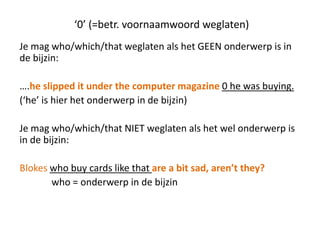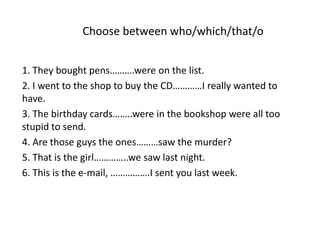5
- 1. 5.6 Betrekkelijk voornaamwoord Who Which That O
- 2. Betrekkelijk Gebruik je voorŌĆ” Voorbeeld voornaamwoord Who personen Blokes who buy cards like thatŌĆ” Which Dingen The magazine which he bought yesterdayŌĆ” That Personen of dingen ŌĆ”.small animals that look like deer? O Zie volgende dia
- 3. ŌĆś0ŌĆÖ (=betr. voornaamwoord weglaten) Je mag who/which/that weglaten als het GEEN onderwerp is in de bijzin: ŌĆ”.he slipped it under the computer magazine 0 he was buying. (ŌĆśheŌĆÖ is hier het onderwerp in de bijzin) Je mag who/which/that NIET weglaten als het wel onderwerp is in de bijzin: Blokes who buy cards like that are a bit sad, arenŌĆÖt they? who = onderwerp in de bijzin
- 4. Choose between who/which/that/o 1. They bought pensŌĆ”ŌĆ”ŌĆ”.were on the list. 2. I went to the shop to buy the CDŌĆ”ŌĆ”ŌĆ”ŌĆ”I really wanted to have. 3. The birthday cardsŌĆ”ŌĆ”..were in the bookshop were all too stupid to send. 4. Are those guys the onesŌĆ”ŌĆ”ŌĆ”saw the murder? 5. That is the girlŌĆ”ŌĆ”ŌĆ”ŌĆ”..we saw last night. 6. This is the e-mail, ŌĆ”ŌĆ”ŌĆ”ŌĆ”ŌĆ”.I sent you last week.
- 5. Choose between who/which/that/o 1. They bought pensŌĆ”which/thatŌĆ”ŌĆ”.were on the list. 2. I went to the shop to buy the CDŌĆ”ŌĆ”which/that/OŌĆ”ŌĆ”I really wanted to have. 3. The birthday cardsŌĆ”which/thatŌĆ”..were in the bookshop were all too stupid to send. 4. Are those guys the onesŌĆ”who/thatŌĆ”ŌĆ”saw the murder? 5. That is the girlŌĆ”ŌĆ”who/OŌĆ”ŌĆ”..we saw last night. 6. This is the e-mail ŌĆ”which/that/OŌĆ”ŌĆ”ŌĆ”ŌĆ”.I sent you last week.





